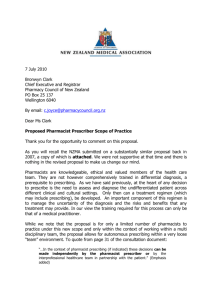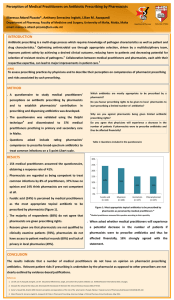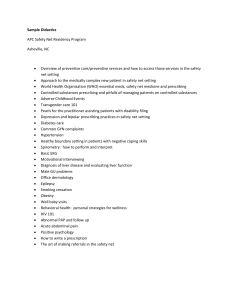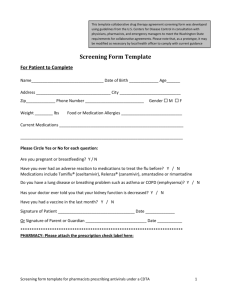PERCEPTIONS OF POTENTIAL ANTIBIOTIC PRESCRIBING BY PHARMACISTS
advertisement
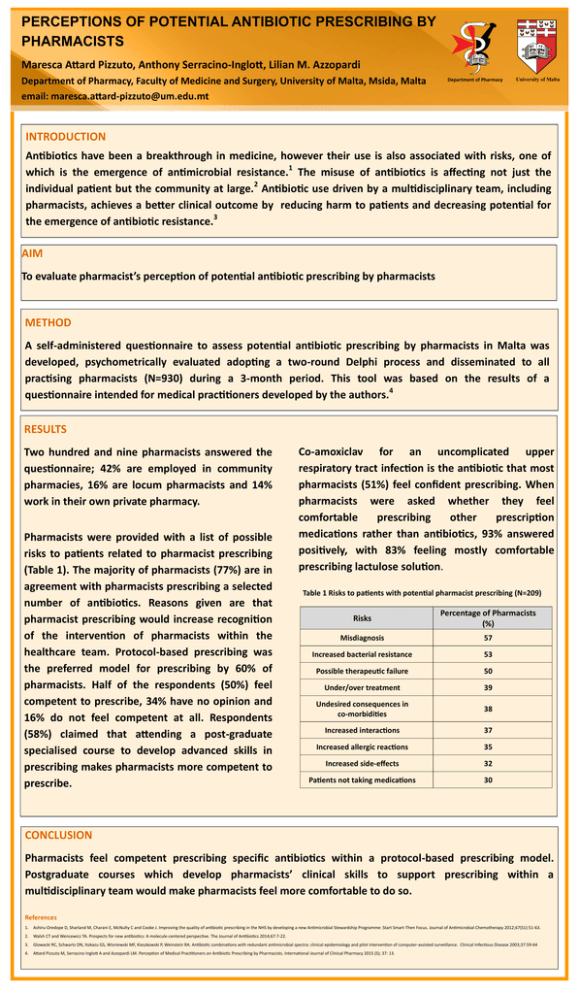
PERCEPTIONS OF POTENTIAL ANTIBIOTIC PRESCRIBING BY PHARMACISTS DEPARTMENT OF PHARM ACY UNIVERSI TY OF MA LTA Maresca Attard Pizzuto, Anthony Serracino-Inglott, Lilian M. Azzopardi Department of Pharmacy, Faculty of Medicine and Surgery, University of Malta, Msida, Malta email: maresca.attard-pizzuto@um.edu.mt Department of Pharmacy University of Malta INTRODUCTION Antibiotics have been a breakthrough in medicine, however their use is also associated with risks, one of 1 which is the emergence of antimicrobial resistance. The misuse of antibiotics is affecting not just the 2 individual patient but the community at large. Antibiotic use driven by a multidisciplinary team, including pharmacists, achieves a better clinical outcome by reducing harm to patients and decreasing potential for 3 the emergence of antibiotic resistance. AIM To evaluate pharmacist’s perception of potential antibiotic prescribing by pharmacists METHOD A self-administered questionnaire to assess potential antibiotic prescribing by pharmacists in Malta was developed, psychometrically evaluated adopting a two-round Delphi process and disseminated to all practising pharmacists (N=930) during a 3-month period. This tool was based on the results of a 4 questionnaire intended for medical practitioners developed by the authors. RESULTS Two hundred and nine pharmacists answered the questionnaire; 42% are employed in community pharmacies, 16% are locum pharmacists and 14% work in their own private pharmacy. Pharmacists were provided with a list of possible risks to patients related to pharmacist prescribing (Table 1). The majority of pharmacists (77%) are in agreement with pharmacists prescribing a selected number of antibiotics. Reasons given are that pharmacist prescribing would increase recognition of the intervention of pharmacists within the healthcare team. Protocol-based prescribing was the preferred model for prescribing by 60% of pharmacists. Half of the respondents (50%) feel competent to prescribe, 34% have no opinion and 16% do not feel competent at all. Respondents (58%) claimed that attending a post-graduate specialised course to develop advanced skills in prescribing makes pharmacists more competent to prescribe. Co-amoxiclav for an uncomplicated upper respiratory tract infection is the antibiotic that most pharmacists (51%) feel confident prescribing. When pharmacists were asked whether they feel comfortable prescribing other prescription medications rather than antibiotics, 93% answered positively, with 83% feeling mostly comfortable prescribing lactulose solution. Table 1 Risks to patients with potential pharmacist prescribing (N=209) Risks Percentage of Pharmacists (%) Misdiagnosis 57 Increased bacterial resistance 53 Possible therapeutic failure 50 Under/over treatment 39 Undesired consequences in co-morbidities 38 Increased interactions 37 Increased allergic reactions 35 Increased side-effects 32 Patients not taking medications 30 CONCLUSION Pharmacists feel competent prescribing specific antibiotics within a protocol-based prescribing model. Postgraduate courses which develop pharmacists’ clinical skills to support prescribing within a multidisciplinary team would make pharmacists feel more comfortable to do so. References 1. Ashiru-Oredope D, Sharland M, Charani E, McNulty C and Cooke J. Improving the quality of antibiotic prescribing in the NHS by developing a new Antimicrobial Stewardship Programme: Start Smart-Then Focus. Journal of Antimicrobial Chemotherapy 2012;67(S1):51-63. 2. Walsh CT and Wencewicz TA. Prospects for new antibiotics: A molecule-centered perspective. The Journal of Antibiotics 2014;67:7-22. 3. Glowacki RC, Schwartz DN, Itokazu GS, Wisniewski MF, Kieszkowski P, Weinstein RA. Antibiotic combinations with redundant antimicrobial spectra: clinical epidemiology and pilot intervention of computer-assisted surveillance. Clinical Infectious Disease 2003;37:59-64 4. Attard Pizzuto M, Serracino Inglott A and Azzopardi LM. Perception of Medical Practitioners on Antibiotic Prescribing by Pharmacists. International Journal of Clinical Pharmacy 2015 (S); 37: 13.
